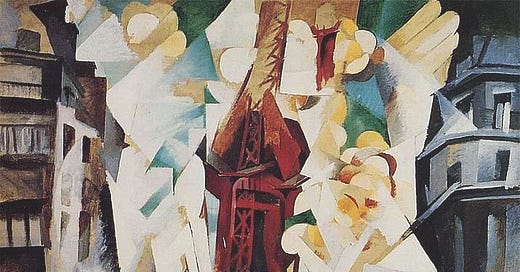When Delaunay began painting his ‘The Red Tower’, the Eiffel Tower was a relatively new addition to the Parisian skyline, having been completed by the Gustave Eiffel, in 1889. It was only 22 years old, yet it was already a symbol of progress and industrialization, representing the spirit of the age. Rising 1063 feet (about 324 metres) above the city, it was the tallest structure in the world until 1930.
The Eiffel Tower held immense cultural significance for Parisians. It represented progress, industrialization, and the spirit of the age. It has certainly had an effect on Robert Delaunay, a French painter who believed that colour had its own language, its own magic. And he spoke it fluently.
Robert Delaunay (1885-1941), a prominent figure in the Orphism movement—an offshoot of Cubism that emphasized the use of strong colours and geometric shapes—found in the Eiffel Tower an inexhaustible source of inspiration. To him, the Tower was more than just a structure; it was a symbol of the new, modern world that was emerging around him. In 1911, he painted fifty-one canvases of the Eiffel Tower, a testament to his relentless pursuit of capturing its essence.
In a compelling piece written in 1924, about Delaunay’s captivating painting, the Swiss-born novelist and poet,Blaise Cendrars, (originally born Frédéric-Louis Sauser), offers a vivid examination of the artist's vision.1
No art formula known until then could make the pretense of resolving plasticity the problem of Eiffel Tower. Realism made itsmaller; the old laws of Italian perspective made it look thinner. The Tower rose above Paris, as slender as a hat pin. When we walked away from it, it dominated Paris, stiff and perpendicular; when we approached it, it bowed and leaned out over us. Seen from the first platform, it wound like a cork-screw, and seen from the top, it collapsed under its own weight, its legs spread out, its neck sunk in. Delaunay also wanted to depict Paris around it, to situate it. We tried all points of view, we looked at it from all angles, from all sides, and its sharpest profile is the one you can see from the Passy footbridge. And those thousands of tons of iron, those 35 million bolts, those 100 metres high of interlaced girders and beams, thouse four arcs with a spread of 100 metres, all that jellylike mass flirted with us. On certain spring days it was supple and laughing and opened its parasol of clouds under our very nose. On certain stormy days it sulked, sour and ungracious; it seemed cold. …
By pushing the boundaries of how colours and form could be used to convey the excitement of the modern world, Robert Delaunay did not merely depict the Eiffel Tower; he reimagined it, infusing it with new meanings while preserving its timeless allure.
Extract from the book, Tranforming Vision: Writers on Art. The Art Institute of Chicago, 1994




